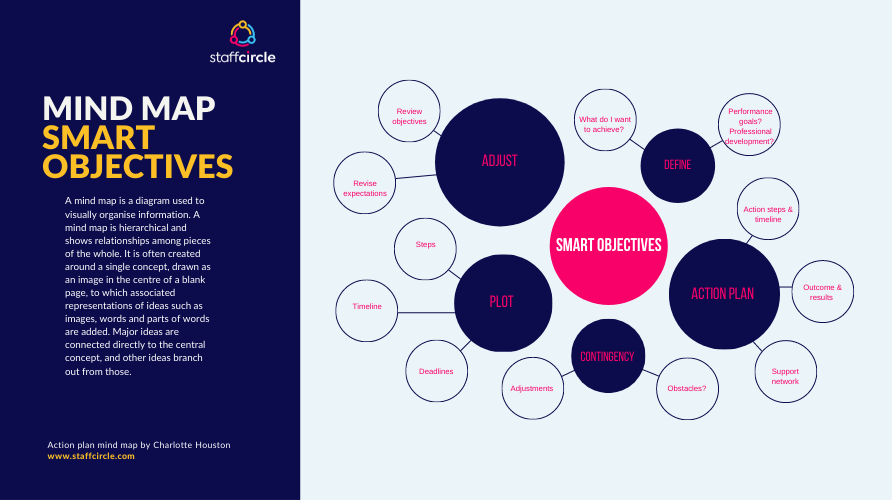Understanding how to set SMART objectives correctly can make the difference between success and failure.
This guide breaks down the process into six simple steps to make sure you get maximum value from your SMART objectives.
I don’t care how much power, brilliance or energy you have, if you don’t harness it and focus it on a specific target, and hold it there, you’re never going to accomplish as much as your ability warrants.
Zig Ziglar, motivational speaker
What is SMART Objectives?
SMART objectives are a powerful tool for setting and achieving goals. The acronym stands for Specific, Measurable, Achievable, Relevant, and Time-bound. This means that when creating an objective using the SMART framework, it should be clearly defined, measurable, realistic and achievable within a certain timeframe.
However, understanding the concept of SMART objectives is only half the battle. It’s crucial to know how to set them correctly in order to reap their benefits.
This guide will explore each of these steps so you can know exactly how to set objectives at work to achieve the best results.
Why Use Goals?
Elaine Houston’s article in Positive Psychology outlines the benefits of clear goal setting:
“Goal setting involves planning for the future. MacLeod, Coates & Hetherton (2008) found that goal setting and skill-oriented planning significantly improved subjective well-being in those who took part in a goal-setting intervention program. Thinking positively about the future bolsters our ability to create goals and consider the actions required to achieve them.”
By using SMART goals, employees:
- Have increased clarity around expectations and results
- Are fully committed to delivering an outcome
- Engage in consistent and regular feedback with managers and colleagues
- Understand the complexity of a given goal
- Increase productivity and engagement through rising to a challenge

1. Define What You Want to Achieve
The first step when creating SMART goals and understanding how to set work objectives is to decide what it is you want to achieve. Goals come in a wide range of types, and deciding what goals you’re aiming for will shape the rest of the process.
There are two main categories of goals. Performance goals are those which relate directly to an employee’s day-to-day role. For example:
- Deliver 10 designs to clients by the end of the next quarter
- Reduce the use of environmentally damaging materials in packaging by 10%
- Increase monthly sales by 15%
- Reduce the risk of supply chain disruption by bringing on board 3 new suppliers
- Reduce staff turnover by 10%
Performance goals can be easily measured and broken down into smaller milestones.
Another common type of SMART goal relates to professional development. Examples of professional development goals include:
- Take a course to improve communications skills
- Mentor an employee for an hour each week for the next quarter
- Read through a suggested reading list on a given topic related to the role
- Conduct 4 meetings a month to develop presentation skills
- Learn a new technology related to your role and responsibilities
Tracking and measuring progress towards soft skills can be more complicated than for performance goals. It’s easy to verify whether or not a course has been completed. But judging how well the employee translates those skills to their role requires additional feedback mechanisms. We’ll touch on this in more detail in the next section.
When objective setting at work, these goals also need to be relevant. Are they tied into the company’s broader aims? Is the individual working towards a goal that benefits their team and department? Make sure your goals are linked to the company’s overall mission before you commit.
2. Make Sure Your Goal is Specific and Measurable
Once you’ve decided on the goals you want to achieve, you then need to select the metrics by which they are measured. This helps to make sure the employee and their manager can track them in real-time to chart progress towards success. It also gives you the milestones you can use to track them through performance management software.
When considering if the goal is specific, ask the following questions:
- Who needs to be involved to achieve the goal?
- What precisely are you trying to achieve?
- When does the goal need to be achieved?
- Why are you setting the goal? What is its primary reason?
- How do you intend to manage and coordinate the work required?
SMART goals also need to be measurable. This means deciding what metrics to use so you can track progress over time. Is it a short-term goal, or a long-term goal that could take weeks or months to complete? How are you planning to collect data related to the goal?
Goals related to productivity and output can be measured in values such as money saved, items produced, and additional income. These goals can be measured with tangible data which everyone involved is clear on.

Using 360-degree Feedback to Assess Soft Skills
360-degree feedback is an effective way to measure goals related to professional development and soft skills. If the goal is to improve communications skills, conducting a 360-degree feedback session before and after is essential.
Colleagues, direct reports, and external clients familiar with the employee will be able to respond to relevant surveys. If they are undergoing communication skills training, these surveys will give a before and after overview of the development of this skill.
3. Create a Plan of Action to Achieve Your Objectives
Every minute you spend in planning saves 10 minutes in execution; this gives you a 1,000 percent return on energy!
Brian Tracy, author and motivational speaker
Understanding how to set objectives and then achieving them needs a clear structure. This can be done through an action plan. The employee should work closely with their immediate manager to put this plan together. This way, everyone is clear on expectations at each step of the plan.
An action plan can be broken down into the following sections:
Outcome and Results
Include a brief summary of the expected outcome at the top of the action plan. This will keep the overall results intended at the forefront of your mind.
Action Steps and Timeline
Detail the steps to be taken in this section in chronological order. If this requires liaising with other people, add the dates for upcoming meetings here. If you’re using performance management software, you should schedule these in advance and set notifications for everyone involved.
Support Network
List the people who can help you to achieve your SMART objectives. This could be a mentor or coach, colleagues with relevant skills, or people outside the company such as training course leaders.
Potential Obstacles
In this section, list all potential obstacles to the successful completion of the objective. This could be personal obstacles (not knowing a certain task), or external obstacles such as unresponsive clients. Understanding where obstacles to success lie makes it easier to plan around them.
Adjustments
Planning ahead means foreseeing potential adjustments down the line. If things start to go wrong, can you switch tracks and avoid failure? We’ll discuss the concept of adjusting your SMART goals in more detail later.
4. Break Down Your Goal Into Smaller Steps That Can Be Easily Tracked
Goals are much easier to achieve when they are broken down into easy to manage smaller steps. This prevents them from becoming overwhelming and gives employees something to aim at over the short term. This is as relevant for personal goals such as losing weight as it is for professional goals.
In her article for the Harvard Business Review, Why We Procrastinate When We Have Long Deadlines, Meng Zhu explains:
“Longer deadlines can lead workers to think an assignment is harder than it actually is, which causes them to commit more resources to the work. This, in turn, increases how much they procrastinate and their likelihood of quitting.”
Zhu goes on to explain how “when deadlines are distant, managers can shift people’s attention away from the deadline and toward the final outcomes of everyday tasks. Reminding employees of the final payoffs of different tasks is an effective way to do this.”
One of the key aspects of how to set SMART objectives involves breaking them down into easily managed smaller steps. Performance management software can be used to monitor each of these steps in real-time. By using a dashboard feature, employees can view progress on a daily basis and understand their priorities.
5. Set a Deadline for Achieving Your Goal
Open-ended goals can be useful in some situations, for instance when developing soft skills. However, as a general rule of thumb, you should always set clear deadlines and any goals and objectives you set.
As we’ve touched on earlier, these can also be broken down into milestones. The employee can use these to see what progress is being made before the final deadline arrives.
When setting deadlines, consider:
- Any training which may be required. If so, how long do you expect this to take.
- Reliance on third parties for support to accomplish your goals. This could be a factor in how long it will take to achieve.
- Overestimating your deadline. Some additional leeway when appropriate can help relieve pressure and ensure a quality end result.
- Prioritising goals by sensitivity. The time-bound aspect of SMART objectives applies to order of importance as well as overall deadlines.
- Anything else you have scheduled. Other expectations may clash with your SMART objectives. Check your calendar to make sure there are no conflicts.
Once you’ve considered all the variables you can set a firm deadline for both the overall SMART objective and any relevant milestones.
6. Revisit and Adjust Your Goals as Needed
It’s a good idea to revisit and review your SMART objectives on a regular basis. This gives you opportunities to revise expectations, adjust milestones, and make sure it still fits the criteria.
Performance management software offers a range of tools to help you to revise and adjust your SMART goals.
Objectives and Key Results (OKRs) Tracking
Objectives and key results can be used to input and track SMART objectives. Any milestones set can be included, while progress towards goals can be measured in a variety of ways. This progress can be expressed as a percentage or a simple yes/no, with alerts sent to indicate upcoming milestones.
Real-time Feedback
Performance management software allows for proactive feedback. Managers and team leaders can keep an eye on employee progress towards SMART goals and step in when things veer off track.
One2one Check-ins
Regular one2one check-ins are an effective way to keep on top of any issues relating to SMART goals. These can be scheduled through performance management software to make sure they are held consistently. Such meetings help keep employees engaged on the task at hand and can be used to adjust goals when necessary.





